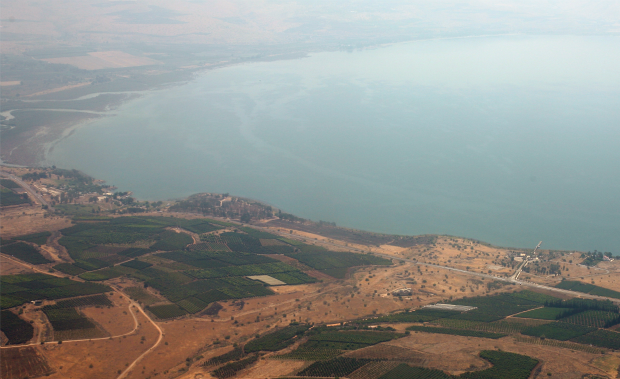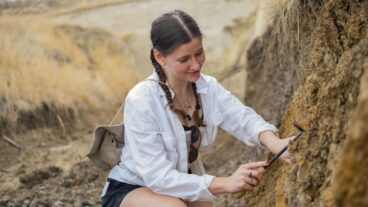Did you know that Israel’s famous Sea of Galilee is actually a lake? It’s had a variety of names since biblical times, but in Israel it’s called Lake Kinneret, and it holds several distinctions: the largest freshwater reservoir in Israel, the only natural freshwater lake in Israel and the lowest freshwater lake in the world. (The only lower lake is the Dead Sea, also in Israel.)
No matter what you call it, the Kinneret is the focal point of the Galilee. Its cool waters are surrounded by both sandy and rocky beaches, kibbutzim – including the very first one, Degania (“Cornflower”) — and a huge assortment of historic, natural, archeological, recreational and religious attractions that bring in visitors from all over the world.
Spread the Word
• Email this article to friends or colleagues
• Share this article on Facebook or Twitter
• Write about and link to this article on your blog
• Local relevancy? Send this article to your local press
On our top 10 list of places to explore around the Kinneret, we have not included the many significant Christian sites. Watch for a list of those places to visit on ISRAEL21c at a later time.
1. Water sports and recreation
What would a lake be without some wet fun? Cruise the lake in a floating restaurant, nightclub yacht, fishing boat, kayak or canoe – all available to rent or book in advance on the shoreline, particularly at the Yigal Alon Harbor in Tiberias. Or splash around at one of three water amusement parks in the vicinity.
If you really want to be adventurous, go kite surfing or windsurfing, or book a cruise operated by the Kinneret Sailing Company. (04-665-8008)
2. Hot Springs
The Kinneret area has long been famous for its natural hot springs.
Tiberias Hot Springs consists of ancient pools fed by 17 natural springs, where you can get massages, mud treatments and Turkish baths. The site has indoor and outdoor thermo-mineral pools, a hot tub, heated swimming pool, private beach (with separate area for religiously observant bathers), saunas and gym.
Hamat Gader Hot Springs spa is about five miles southeast of the lake. The thermo-mineral springs, including a hot waterfall, measure 42 degrees Celsius (100 Fahrenheit) all year long. The ancient Romans built their second-largest bath complex (Israel’s largest) here 2,000 years ago. Today you can get a full range of pampering and therapeutic treatments, and even stay on-site in a suite hotel. There’s also an ancient synagogue, with a beautiful mosaic floor, open to visitors. (04-665-9964)
The surrounding Hamat Gader Park consists of 40 acres of tropical parkland with covered outdoor settings, restaurants and one of the largest crocodile farms in the Middle East, housing about 200 of the reptiles. (04-665-9999)
Situated within the local basalt landscape overlooking the Kinneret, this site contains the preserved remains of the ancient Jewish town of Korazim, known for its cultivated fine wheat. You can see a Bedouin sheikh’s tomb and explore a fourth-century basalt synagogue, where archeologists found the Aramaic-inscribed “Moses Seat” described in ancient sources as a place of honor for the community’s hot-shots. You can’t sit on it, but you can stake out a picnic table set among the Christ-thorn jujube trees and Mount Tabor oak. (04-693-4982)
4. Naharayim (“Two rivers”) and Island of Peace
Straddling the Jordan and Yarmuk rivers near the Kinneret, Naharayim was the site of the first hydroelectric power plant in pre-state Israel, which no longer functions but is open for tours. This border area is where Israel and Jordan signed their 1994 peace treaty, and accordingly the site became known as the Island of Peace.
A scenic walking path takes you through the Island of Peace along the dams and the Yarmuk waterfalls. Displays include a vintage bridge and inn, border post, bus, train and armored vehicle. A guided tour goes to the Hill of Plucked Flowers, a garden memorializing seven Israeli schoolgirls murdered by a deranged Jordanian soldier here in 1997.

Nearby Kibbutz Gesher – one of two kibbutzim that manage the site — offers a light-and-sound show, “Legend of Bread” baking workshops and an underground museum about Israel’s wars since 1948. (04-675-2685)
5. The Daliyot Stream (Majraseh) Reserve
Encompassing 1,750 acres, the Majraseh is Israel’s largest reserve of natural freshwater landscapes — the wetlands of Bethsaida Valley, plus pools, springs and fishing lagoons. A paved trail leads to the Daliyot Stream, where you can wade downstream to a staircase leading up to a eucalyptus grove, or continue to the end of the marked trail.
An alternative dry route takes hikers along the southern bank to a picnic area in the eucalyptus grove. The valley is connected with the ancient city of Bethsaida, where archeologists are excavating Bronze Age and Iron Age remains as well as remnants of the Roman period. (04-679-3410)
6. Kibbutz Degania Aleph and Bet (A and B)
Degania Aleph’s Gordon House, founded in 1935, was one of the first nature museums in Israel. Its artifacts date back to prehistoric times until the beginning of Zionism. It has a diverse taxidermy collection, films about the local nature and settlement of the area and an archeological display. And there are personal items and letters from A.D. Gordon, a pioneer hero of the “Second Aliyah,” the second wave of immigration from Russia between 1904 and 1914. (04-675-0040)
Go over to neighboring Degania Bet, founded in 1920, for a three-hour chocolate-making workshop at Galita Chocolate Farm, a factory and retail outlet housed in a former cowshed. Proprietress Galit Alpert also runs a coffee bar where you can sample her homemade ice cream. (04-675-5608)
7. The Yigal Alon Center, a.k.a. “The Jesus Boat Museum”
Located at Kibbutz Ginosar, this museum has a separate hall housing the so-called “Jesus boat” – a 2,000-year-old craft of eight meters long that was discovered in the 1980s when a drought in Israel caused the water level in the Kinneret to fall dramatically. The center’s other galleries trace the history of civilization and nature in the area, and showcase artworks made by Arabs and Jews of the Galilee. Alon was a founding member of the kibbutz, an active participant in the pre-state settlement movement, an officer in the Palmach and a government minister. (04-672-7700)
8. Circle the lake
You can walk or bike around the Sea of Galilee on the new 60-kilometer Shvil Sovev Kinneret. Rent a cycle and begin the route at Kibbutz HaOn and continue past the Degania Dam to Kibbutz Kinneret.
Not into pumping your legs? Try Jordan Carriages, a horse-drawn trip in the southern Jordan River area accompanied by local lore and songs; hire a jeep or ATV guide; or hop on the free “Around the Sea of Galilee” bus line, which run from Tiberias to all of the Kinneret beaches. (*55477).
A Kibbutz Experience train takes visitors through the kibbutz, which offers lakeside guesthouses on the eastern shore of the Kinneret. The 30-minute guided tour explains how the kibbutz, founded in 1937 by a group including Teddy Kollek, future mayor of Jerusalem, weathered attacks from Syria until the Six-Day War.
At Saba (“Grandpa”) Yosi’s Workshop on the harbor, kids and parents may build (or buy) wooden toys and climb the pirate ship built by Saba Yosi. Also on the kibbutz is the 200 Art Gallery and the House of Anchors museum, boasting a unique collection of fishing-related artifacts found around the lake area from the past 3,000 years.
10. Sound-and-light show on the lake
A 15-minute, state-of-the-art multimedia presentation is shown free of charge every evening on the southern end of the Tiberias lakeside promenade. Four shows projected onto two huge water screens colorfully highlight the development of the area, accompanied by classical music. You’ll see dancing fountains styled on the famous one at the Bellagio Hotel in Las Vegas; pyrotechnics screened onto jets of water reaching 30 feet into the night sky; and a laser show. Catch the action at 8:30, 9:30 or 10 p.m.






















